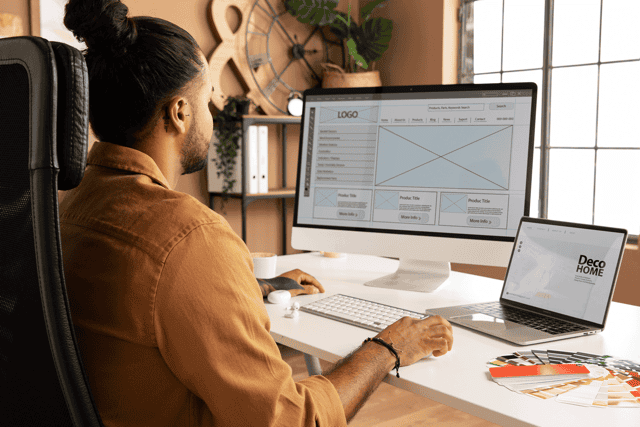Rapid prototyping used to be only used for physical products but has since then been making waves in the world of software development too. Rapid prototyping started in the manufacturing sector. Design teams used computer-aided design software to make prototypes of their products. They’d create physical models with 3D printing technology to test out their ideas and see if they worked. Now, those prototyping techniques found their way into software development. The tools used are different but the core concept remains the same – try things out, learn from them and make your software better in the process.
First things first: What is rapid prototyping?
Picture this: A team of developers are tasked with creating a new mobile application that needs to serve a specific purpose. They start by gathering requirements and brainstorming ideas. Instead of diving straight into extensive coding, they decide to adopt a rapid prototyping approach. The team begins by creating a basic wireframe or sketch of the app’s main screens and functionalities. They use simple tools like paper and pencil or digital prototyping software to quickly visualise the user interface (UI) and overall user experience (UX) flow.
Once the initial wireframe is ready, the team shares it with stakeholders, including designers, product managers and potential users. They gather feedback and suggestions for improvements. This early feedback loop is crucial as it helps identify potential usability issues, clarify requirements and refine the app’s concept. Based on the feedback, the team quickly iterates on the wireframe, making necessary adjustments and enhancements. They might add or remove features, modify the layout or experiment with different UI elements. This iterative process allows them to rapidly refine the app’s design and functionality, saving both time and effort in the long run.
With an updated wireframe, the team proceeds to build a clickable prototype or a minimal viable product (MVP) using low-code or rapid development tools. This prototype simulates the app’s behaviour and interactions, giving stakeholders a tangible experience of how the final product will look and function.
Let’s break down the rapid prototyping process into three simple steps:
Step 1: Prototyping – The team gets their creative juices flowing and brings the design specifications to life with one or more rapid prototypes. These prototypes are like visual blueprints, giving everyone a taste of what the final product will look and feel like.
Step 2: Feedback – Now it’s time to share the prototypes with the world (or at least your team, stakeholders and focus groups of end-users). It’s like a mini unveiling where everyone gets to play around with the prototype. They’ll evaluate the design, poke at the usability and let you know what’s working and what needs improvement.
Step 3: Improvement – Armed with all that feedback, it’s time to dive back into the design process. The design team takes the suggestions, the critiques and the ideas and use them to create a new iteration of your prototype.
You get two types of prototypes: Low-Fidelity and High-Fidelity
Low-Fidelity Prototypes:
Imagine a paper sketch or a simple wireframe. It’s like the blueprint of your software, giving you a bird’s-eye view of its basic structure. It’s not interactive and there’s no mistaking it for the real deal. Low-fidelity prototypes are perfect for visualising the core building blocks of your app or website.
High-Fidelity Prototypes:
A prototype that looks and feels like the real deal. Buttons are clickable, menus are interactive and every little detail is meticulously crafted. Creating high-fidelity prototypes takes a bit more time and effort, but they allow stakeholders and investors to inspect your design decisions in all their glory.
Rapid prototyping and agile: two sides of the coin
As previously mentioned, rapid prototyping does not require teams to dive into coding from the start, its more focused on getting the design just right by making use of sketches, wireframes etc.
Agile takes a different approach, but it still makes use of various iterations. The team jumps into the development phase and starts crafting a Minimum Viable Product (MVP). It’s like a mini version of the final product. Instead of discarding the MVP and starting from scratch, the agile team embraces the beauty of iteration. They test it, improve it and repeat the process over multiple cycles. It’s a relentless pursuit of perfection, where the MVP keeps evolving and growing until it blossoms into the final product.
Rapid prototyping focuses on design practices, while agile is all about software development. They both have a place in the development world, but they dance to different tunes. However, in certain situations, you might find them teaming up and working hand in hand. Rapid prototyping can join forces with agile when it’s crucial to gather feedback early on, even before the development of the MVP starts.
7 Incredible Benefits of Rapid Prototyping
- Prototyping takes you on a fast-paced journey of improvement. Short cycles, sometimes just a few days or a week, allow for rapid enhancements to the core design.
- Time is precious, and rapid prototyping ensures you spend it wisely. Rather than getting lost in a sea of details, this approach forces you to prioritise the key features that have the most impact.
- User-centric design is at the heart of rapid prototyping. By emphasising end-user testing and feedback from the get-go, you refine your design with usability and customer experience in mind.
- With prototypes, you can spot crucial issues early on, saving precious development time and resources.
- Prototyping brings everyone together in a collaborative environment. By involving a diverse range of perspectives, you increase the chances of delivering a finished product that meets everyone’s expectations.
- Rapid prototyping is your safety net. The low cost of prototyping compared to full-blown development means you can identify and address potential problems early on.
- Accelerated app development means you can hit the market sooner, potentially claiming a larger market share by being among the first to deliver a remarkable product.
The bottom line: rapid prototyping is a game-changer in software development. With its many benefits, such as quick iterations, focused feature improvement and user-centric design, this approach paves the way for success in bringing your ideas to life.
Turn to the experts at Warp Development, where we specialise in transforming ideas into exceptional software solutions.
Book a consultation here.




